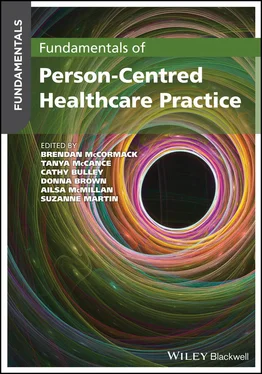1 ...7 8 9 11 12 13 ...26 There are multiple philosophical perspectives to what constitutes a person and personhood.
Persons are more than their physical and cognitive make‐up, but instead constitute a dynamic interrelationship of multiple factors that come together as personhood.
Personhood is the key characteristic that distinguishes persons from non‐persons.
Values are a key part of our personhood.
1 Dewing, J. (2012). Bringing Merleau‐Ponty's inspirations to working with participants. In: Creative Spaces for Qualitative Researching, Living Research (eds. J. Higgs, A. Titchen, D. Horsfall and D. Bridges), 65–76. Amsterdam: Sense Publications.
2 Dewing, J. (2019). On being a person. In: Dementia Reconsidered, Revisited (ed. D. Brooker), 17–23. London: Open University Press.
3 Frankfurt, H.G. (1989). Freedom of the will and the concept of a person. In: The Inner Citadel: Essays on Individual Autonomy (ed. J. Christman), 63–76. Oxford: Oxford University Press.
4 Leibing, A. (2008). Entangled matters – Alzheimer's, interiority, and the 'unflattening' of the world. Culture, Medicine and Psychiatry 32 (2): 177–193.
5 Nursing and Midwifery Council (2015). The Code: Professional Standards of Practice and Behaviour for Nurses, Midwives and Nursing Associates. London: Nursing and Midwifery Council.
6 Post, S. (2006). Respectare: moral respect for the lives of the deeply forgetful. In: Dementia: Mind, Meaning and the Person (eds. J.C. Hughes, S.J. Louw and S.R. Sabat), 223–224. Oxford: Oxford University Press.
7 Sabat, S.R. (2002). Surviving manifestations of selfhood in Alzheimer’s disease: a case study. Dementia 1 (1): 25–36.
8 Singer, P. (2011). Practical Ethics, 3e. Cambridge: Cambridge University Press.
9 Smith, C. (2003). Moral, Believing Animals: Human Personhood and Culture. Oxford: Oxford University Press.
1 Rogers, C. (2004). A Therapist's View of Psychotherapy: On Becoming a Person. London: Constable & Robinson.
2 Schoenhofer, S.O. (2002). Choosing personhood: intentionality and the theory of nursing as caring. Holistic Nursing Practice 16 (4): 36–40.
3 Singer, P. Ethics, uncertainty and moral progress. www.youtube.com/watch?v=‐NMD0g97C64(18‐minute video)
2 What is person‐centredness?
Brendan McCormack1, Tanya McCance2, and Suzanne Martin2
1 Queen Margaret University, Edinburgh, Scotland, UK
2 Ulster University, Northern Ireland, UK
Introduction
The values of person‐centredness
Person‐centredness and related concepts
Person‐centred practice
Person‐centred culture
Conclusions
Summary
References
Further reading
Understand what person‐centred practice is, distinguishing it from other approaches to practice, for example patient‐centredness, client‐centredness, family‐centredness, woman‐centredness and child‐centredness.
Identify and describe the different challenges posed for healthcare practitioners when adopting person‐centred approaches to practice.
Understand the importance of the need for the development of person‐centred cultures in healthcare organisations.
The term ‘person‐centredness’ is increasingly used in healthcare discourse. Reflecting a desire to keep the person in the centre of decision making, a focus on person‐centredness challenges traditional ideas of (for example) task‐orientated practices, dehumanising of patients through medical labels and system efficiency without considering its impact on persons. In this chapter, we will explore what we mean by person‐centredness with a particular focus on person‐centred practice. In recognising that there are a variety of terms used in healthcare when considering person‐centredness, we will compare and contrast some of these commonly used terms and what they may mean for how person‐centredness is operationalised. Being person‐centred in everyday practice is challenging and so the need for organisations to adopt a whole‐systems approach to person‐centred healthcare will be considered.
Collect a story of a care experience from a relative or friend. Reflect with them the extent to which you consider it to be a person‐centred experience. Identify with the relative or friend the key things that led you to think it was or was not person‐centred.
In your care story, you may have identified key elements that resonated with aspects of persons and personhood from Chapter 1. The story might include issues that reflect the person's key values and beliefs that are important to them. It might have said something about the kinds of relationships they experienced with different healthcare workers and it may say something about the person‐centred processes experienced in the care setting. But you might also be thinking, ‘These issues are so basic and ordinary, why are we having to pay such attention to them?’ In many respects you are right, of course, but we also know that these fundamental aspects of life, that we value so greatly, often get challenged in different healthcare contexts. This happens because of a variety of complex factors that, taken together, turn the ‘ordinariness of the everyday’ into the ‘extraordinariness of healthcare practice’. The Person‐centred Practice Framework that we introduce in Chapter 3picks up on these factors and explores why being person‐centred can be so challenging to achieve.
The values of person‐centredness
Many of the underpinning values of person‐centredness that are dominant in healthcare are not new and, indeed, many can be traced back through the history of healthcare and especially in the context of care and caring, where the core value of ‘respect for the person’ is paramount (McCance et al. 1997, 1999). Table 2.1sets out these core values.
Table 2.1 The core values of person‐centred practice
| Core value |
What the value means in practice |
| Respect for personhood |
Holding the person's values central in decision making is essential to a person‐centred approach to practice |
| Being authentic |
Being ‘real’ in our representation of who we are as persons to enable meaningful engagement in relationships |
| Sharing autonomy |
Forming trusted and interconnected relationships between persons for shared, informed decision making |
| Showing respect for and active engagement with a person's individual abilities, preferences, lifestyles and goals |
Balancing all persons' competence and expertise with individual understandings of well‐being and potential futures |
| Demonstrating mutual respect and understanding |
Forming positive interactive relationships that create an interdependence and shared energy |
| Therapeutically caring |
Caring as a therapeutic intervention focusing on actions that respond to individual need and that strives for positive outcomes |
| Committed to healthfulness as process and outcome |
Living a positive life and embracing all dimensions of our being |
Consider these core values from the perspective of the work you did for Activity 3 in Chapter 1. Are there similarities between these core values of person‐centredness and your personal values? List the similarities and differences. Write a 100‐word reflection that captures how you as a person connect with these person‐centred values.
Читать дальше












